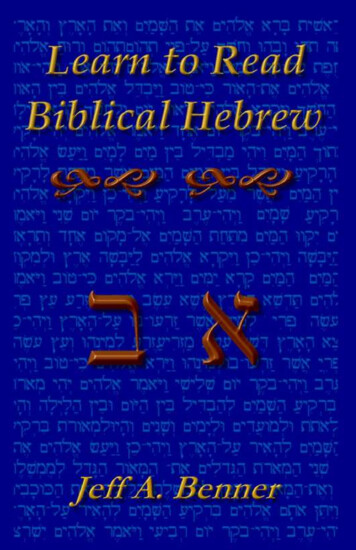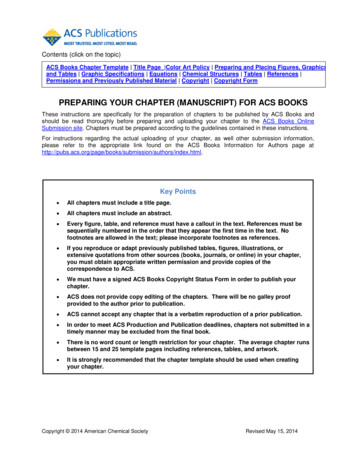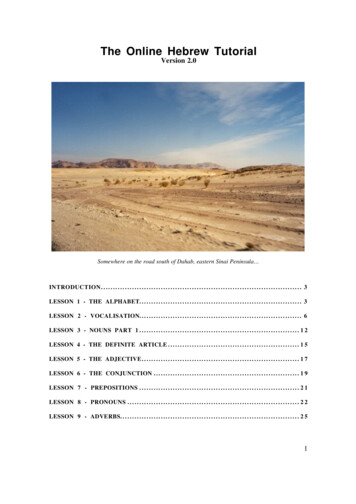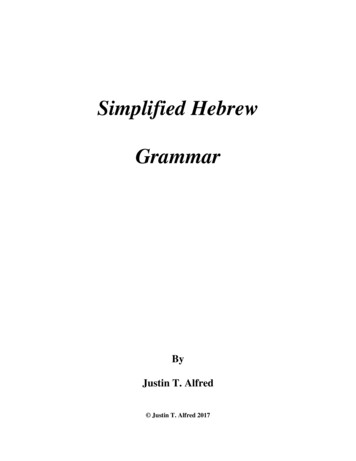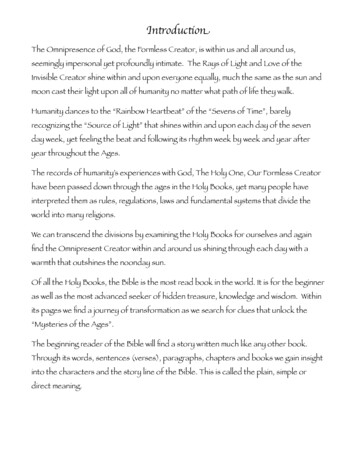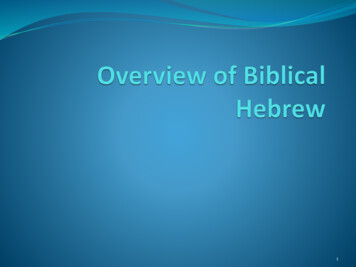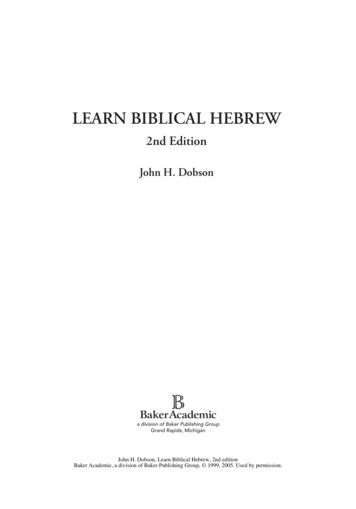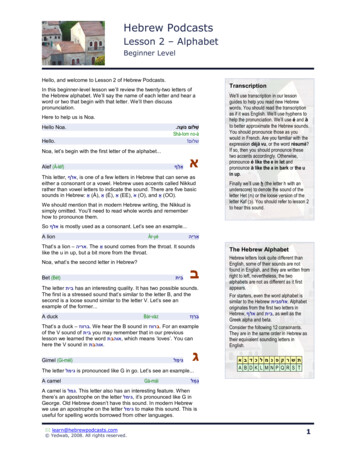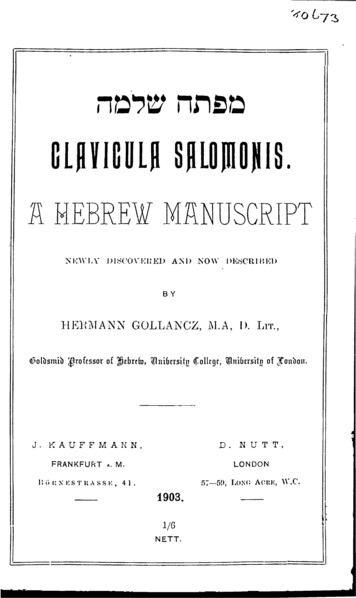
Transcription
V o 6 -7 3 ,7\& w n n s aCLflVICULfl SPLOmOHIS.R HEBREW MANUSCRIPTN K W IA 'DISCO Y'K It ED AND NOWDKSC’ RI HKDBYNEUMANN GOJLLANCZ, M.A, I . Lit.,Qpolbsmib professor of pebrefo, fthubcrsitn College, luibersitn of Tonbon.J.K A U F F M A NFRANKFURTa.D. NUTT,N,LONDONM.I! ii 1; X K S T R A S S K , 4 1 .57—59, LoNfi A ork, W.C.4903.1/6NETT.
VrJ
DEDICATEDTO M YDR.REVERED TEACHERMI C H A E LAND FRIENDFRIEDLANDER IN HONOUR OFisseventiethBirtbdap.
[(.jy' mTm)\m HRhe manuscript described in these pages willoffer to the student of ancient and modern literaturemuch information regarding that branch of learningwhich deals with the world of mystery,— a themewhich from time immemorial up to the presentday has ever had a remarkable fascination for themind of man.The substance of this work might, as far asconcerns its practical value, be looked upon as acombination of folly and daring; but from anotherpoint of view, namely, that works of this kind wereduring the past sought after, studied and believedin, the MS. before us assumes a character of highimportance.The Essenes, mentioned by Josephusand Philo, hadalready introduced into their religious activity someelements of a mystic tendency, and the Therapeutaeof Alexandria were not behindhand in this direc tion.Their healing-art consisted in the applicationof mystic formulae derived from the works of King
— 8 —Solomon (Josephus, Antiq. VIII, rr, 5 ).We findtraces of this mysticism as the background ot theart of healing in the New Testament itself.In theOld Testament, of course, witchcraft is looked uponas an abomination; it is forbidden and punishable bydeath.Nevertheless, the spirit of man ever gropingabout in the dark was wont at all times, before thedawn of civilisation, to thirst and search after thatwhich was hidden and concealed. For the purposeof improving their condition or satisfying theiraspirations, men longed to employ in the absence ofall material visible means of help such methods asthey considered to have been supplied by the mysticworld.Their aim at first was to alter their ownconditions by means of such mystic practices; andany failure with which they met in the course oftheir operations, they attributed to their own personaldefects and want of abilitv.Their faith in themethods which they adopted could not be shaken.It was this very faith in the efficacy of theircraft that gave the opportunity to many an impostorto mislead the simple honest folk who sought theiraid; and these impostors, at least, had no cause to
— 9 —complain that Fate had been unkind to them, andhad not helped them to improve their lot in life.In the New Testament (Acts VIII), it is true,the practice of open sorcery, personified in SimonMagus, is assailed;yet this yearning after theacquisition of the gifts of the world and the satisfac tion of temporal happiness could not be quenchedby means of religion proper, and the unbelievercontinually resorted to the practice of sorcery inorder to bring about, as he thought, the ameliorationof his condition.In the Alpha-Beta of Ben Sira there is alsocited an interesting instance of the practical applica tion of the magic art (Amsterdam Edit. 1696, p.9;the reference is to Nebuchadnezzar).The Talmud ( Sanhedrin 67b.) calls sorcery the,,denial of the Providence of God” :— pnv '3n new: n b y o bw N 'b e s pts nsetp D 'e tjo jew tnpa r\vbA strong indictment against the practice ofmagic is contained in the later, though most im portant work D'TDnn iso by R. Jehuda Hasid.The concluding paragraph of this work is asfollows:—inDm3 n-onisty 'D3p jn o pp'ion pwniyDtrnai D'sirsa ipoy w my'Dp vmDNi win ttroi?
10 —ra il*a na'j/N -i e n ' xb) anad invia' iv p a xin a n a a n ru p x op ic jn*6p c an m K a'j r c p i n iy a a 'n a tt*sa m p ' )b p xi n 'n n D'ran n c « :i sa ':sra trs j p rrn p x i W "t v n 1i: "i&-x bz n x i u j n n m a » ' 'm ‘pan bv D 'ju n m r 6 s n xbx: dni pax Dby; iy"i nnya jn araSorcery continued to flourish during the centur ies down to the middle ages and later times.Itoften, even in modern days, raised altars uponwhich humanbeingswereoffered asvictims.We have but to think of the various trials on theground of sorcery and witchcraft recorded in theannals of European nations.The chief work which is supposed to have servedas the oracle of all sorcerers throughout history isthe famous “ Clavicula Salomonis”.King Solomon who, according to tradition, wasking of the whole world, and who, according to thestatement in Ecclesiastes, could render all the joysand delights of life subservient to his will, stoodforth as the pattern and prototype for all whohankered after the things which they regarded asthe pleasurable and desirable objects of existeiice.The legend mns that it was by means of magicalconjurations that King Solomon the Wise was enabled
11to procure for himself all the delights and pleasuresin which he indulged. A glance at the work ppnrnyp(Livorno, 1790) by the renowned Johanau Allemanno(XV. cent.), and at the liesponsum of lb .JacobProvenciale, 1490, (in the collection ,’C3n n il byElieser Ashkenasi, Metz, 1849), is sufficient to informus as to the number of apocryphal works ascribed toKing Solomon.Gedaliah Jbn Jahya in his book “ Shalshelethhakabala” (Ed. Venice, 1587, f. 98 b.), in referring tosuch works, cites one by namennea—the veryetpiivalent of Clavicula Salomonis.as follows :—iTuSxnHis words are7\vhv nt?yp ominnysa by on D pdjlin y:nxi onpya omninu : my m 'nso -nm msiyyniona nrm:nate nr»3D ntnpaiIn the words of a modern non-Jewish scholar,to whom we shall presently refer by name:—“ Solomon plays the same role in ancient JewishMagic as Faust does in the Christian; it is, therefore,not to be wondered at that books on magic areattributed to him.In addition to the famous0 laviculae Salomonis, the following works areascribed to him:— Liber quatuor annulorum; Liber
tie IX Candariis; Liber de tribus Figuris Spirituumand de Sigillis ad Diemoniacos; Clavicula Salomon is arl{ilium Roboam; Liber Lamene; Liber Rentaculorum;Liber de ofhciis Spirituum; Hygromautia ad filiumRoboam; Testament-urn Salomonis; tlie Book Rasiel,tbe Book Almandal, etc. Compare the writings ofRoger Bacon, Agrippa, Tritheim, Wier, Goldast,Naude, Horst, etc., in which the magic works ofSolomon are mentioned and discussed.”The book “ Clavicula Salomonis” may originallyages ago have been written in Hebrew by someunknown author; a cruel fate overtaking both the*sorcerer and his works, and coinjoletely destroyingthe original manuscript of the said “ Key” .In latertimes what is supposed to be various translations ofit have appeared in the Romance languages.Karl Engel, the great scholar of the Faustlegend, in his work Zusammenstellung dev FanstSchriften von 1G Jahrhundertbis Mitto1884,Oldenburg, 1885 (§VI Salomo, 413 sqq.), has enum erated the various editions of the Clavicula whichhave hitherto appeared. They are as follows:—Clavicula Salomonis Hebraeorum Reeds translatein latinum idioma ex Hebraeo. ;
— 13 —Clavicula Salomonis filii David;.Salomonis Clavicula i.e. Dev Schlussel Salomonis,inagiae et albae et nigrae, [ “ Constantins J\f. hatdieseclavicula von Jerusalemgeschickt320” \Romae, 1510;Claviculae Salomonis et Theosophia pneumatica.Wesel, Duissburg and Frankfurt. Andreas Luppius,1G8G, [A Reprint in Scheible’s Kloster, Vol.III] ;Semvplioras and Sch emit amph or as SalomonisRegis. Wesel, Duissburg and Frankfurt,. AndreasLuppius, 1G8G, [ A Reprint in Scheible’s Kloster,Vol.III, and in his Bibliothek d. Zauber-, GeheimnissundOfienbarungsbucher,Pt.VI.]Claviculae Salomonis, 1G8G, by Luppius;Claris Salomonis et thesaurus etc., translatedby Neydecker, Germany, 171G;ClaviculaSalomonisexplained bySamuelHeineke, Pressburg, 1780;Clavicules de Salomon. dite du PapillonVert. 1827.In addition to these included in Karl Engel’slist, other printed works, versions of the Clavicula,are to be found in the British Museum, e.g:—La Vera Glavicola, Milano, 18G8; La Clctvicolas
14Salomon, Firenze, 1880, etc.The British 1VI useum has also among its treasuressevenlVISS.ii) theLatin,French and Italian languages.They are Add. MSS. 10,802; Sloane MSS. 1407 and8091; HarleianMSS.3981;King’s MSS.288;Landsdowne MSS. 1202 and 1203. Of these Nos.288 and 3981 are French translations of the Italianmade from the Hebrew by Abraham Color no; a copy(in Italian) is, according to Ben Jacob’s bibliographic al work o,"i Dn TiiK (s.v.narn), in the possessionof Professor Steinschneider.In 1889 Mr. S. Liddel Macgregor Mathers,author of the “ Kabbalah unveiled”, by piecing to gether these various MSS. contained in the BritishMuseum, edited “ The, Key o f Solomon the Kitty(Clavicula Salomonis)”.A hurried survey of these very MSS. mighteasil} convince one that they are anything but Jewishin character, several of them containing illustrationswhich, in the eye of the Jewish Law, would beregarded as blasphemous; the human face or moreextended form appeal's in a circle with the wordsHir bn added, the face itself in several instances beingeven supplied witli horns and the form with wings.
With regard, however, to the Hebrew text itself,it seemed, as far as our knowledge went, to he altogether lost, so thatinrecent timesno onetroubled to make a search for it. In fact, it was o-ivenup as lost (C f Mathers, p.V.)Without entering into the reasons for the utterdisappearance of the work in the original, might itnot be found in the fact that in recent centuries thebook had lost its value for the sorcerer, and had aninterest simply for the antiquarian student and thefolk-lorist?As late, however, as in the Faust-leo-end— childof Teutonic soil and of Romance and Slavonicadoption, the Clavicula served as the primary sourceof the Magic Art which figures so prominently in thelegend itself.To come now to the MS. which we are about todescribe, and of which I propose to give an outline.I have lately had the goodfortune to become possessedof what appears to be (as far as 1 am able to judge)a Hebrew Manuscript of the “ Clavicula Salomon is” ,until, this supposed to have been lost. I came acrossthe volume while searching among the books con tained in the library left by my late father, the
Reverend Samuel Marcus Clollancz. *Judging from the Appendices and probably laterTitle-page, the MS. seems to have been copied inthe year 1700. There is Jittle doubt that the copyisthad an older MS. before him; he frequently addscorrections and variants, the result of his own criti cism. It often occurs that in making such correctionshe. employs the expression’"fi' "ien; and once(f.54b) he writes as follows:—: i 'vt's 'nyr rv:n n» nns '"S'pSn mwit* *iv ica smrnWe might clearly infer from these words that thewriter was copying an older text.Our MS. consists of 72 quarto leaves of onepagination and 7 leaves of a second pagination, 157pages in all. The writing is in the Hebraic - Italianhand, the MS. itself being supplied with numerousillustrations. It would appearthat the copyistendeavoured to do his work as carefully as jiossible,inasmuch as he now and again when making a baddrawing confesses to his want of artistic skill, andrepeats his attempt at drawing the same figure onthe opposite page.*My thanks are clue to the eminent bibliographer, 51r. S. Chait,for kind help in this description of the MS.
— 17The MS. has the following title-page:—nsx ib may" m a n o b u ”i sdU':vby 2 -]f?ei 'i xs:j by 2v " *i&*k -.hurt" i a in p. ip ':a 3D masn aim o mnnair y:v \' \ 2 nn« mysa a n ba Kami ciaa mn n;n av.n ijnDi?-iNp ic'p znitrai n3n : i-us npitynS i:n:na toimXjT nnna \"\ b xv'ir jiPNi apyn xin n:,n y"'n3» DTiattfJDX ns.p Sian jlV 'n a:The word between *i D and na fc' indicated bydots cannot be said to be “ illegible,” for it has beencut out. evidently with a purpose, probably frontfear; for it should be borne in mind that a bookbearing the title “ aVc nnsa 'D “ Clavis” or “ ClaviculuSalomonis” might have involved, even at the timeof the latest copyist, in most unpleasant and perhapsserious consequences, both the copyist as well as thepossessor.( )ne has but to look back to the end of the L7thcentury and to the beginning of the 18th, and tothink of the proceedings at the Trials, and the deathsentences in connection with witchcraft and sorcerv.(Cf. Dr. Jaraczewski’s Vortrag liber Hexenprocesse
18in Erfurt n. Cmgogond, Erfurt,I87G, and theaccount of .1.-mo Wen ham’s Trial at the Assizes atHertford and ( Jondom nation to Death, London,! 71*2).The general impression conveyed by a perusalof the work itself is that it is perfectly Jewish intone. The invocations and names contained therein,and the pantheistic spirit underlying the invocationsas well as the formulae are not un-Jewish.TheJ ewisb character of the work as a whole is not affectedby the foreign elements and names introduced inthe appendices and other parts.As an example Iwill but cite here one point contained in a passagefound in folio 46a.In the reply of “ Bilath” theexpression occurs vr.iydemon,which proves that thisinstead of being the enemy of God, is inreality subservient to His Will in reducing thesinning creature.This is certainly Jewish in spirit, since theChristian idea of Lucifer is that of a rebel cast outof Heaven.If, for example, the invocation wereChristian, the author would not have inserted aphrase so contrary to his own doctrine.According to all appearances, the Magic Book“ Clavicula Salomon is” was composed in the East.
19And it is not at all unlikely tluit our MS., in spite ofobviously late additions introducing in the appendixof the work the names of Prague and Vienna, mayhave been brought from the East into Europe byt hose turbulent spirits who acknowledged a Magicianas the Messiah and followed him.Strange to say,there occurs in the appendix to our MS. one passage(fol. 6'a.) which would seem to favour this theory,for it leads us on to a perfectly new track, namely, tothe times of the dreamer and pseudo - Messiah,Sabbatai Zevi.In a variant incorporated in thetext, the veryname W - p (Sabbatai)introducedthe abbreviationbyseems to occur.The name'*1(fol. Oh.) also points to the same origin.Several times the word “ Tetraorammaton”o1the Greek equivalent of JHVH, is used in this MS;this substitution in the Jewish Cabbala was adoptedsolely by Sabbatai Zevi and his party; (Cf. “ BethHamidrash,” Weiss, article by N. Briill, pp. G3and 103).The MS. beginsthus:—o*i cn S'nna p oo'"npai s dn n atpnwinai n"yn naS? myeaw ip*inx i:n;x n:n
— 20 —mnaan nnx nbnnn nrovraa mic’xa mu unba' '*?a lapyaabo nyran n'n',*:x naanm 'n aiaa n\a nbnnna o yaiaab n"y .arabia* a»x nbar na n»» yo' aer n yci pcxrannaxbraa y\r udd ac*x nn?axn aab nbycn aab -parr bxn anxcnaa bx pbnrrty xbx nnx mobtn nnx nbnnn .nnx nbuo’"cyx anx bba nrnb u ir Demean D'pbn.n avn m byi ona.nai nbyo ba nevn ibwta p d: p obw 'nba pix by xina*mbam nbnnn "ixi s sbtt «m airx max n bx Dii acrnbx pnno n:ra\xa pbna yar pam bxn cmn naaanopbn nyn’b mman nn’nara yD’axbtan pnnra ty pbn nyn'bby on onxbian ,'n pbn nyn'b n\ann bixsy bya acxeia 'aby a"; Dmarasym sax ' nnx CTaraa aaib nvn p ’aa 'Jmine 'ta cm la2? pam bxb anary ono nvp asrx d snmran a bvx cna aaab px asrx p i D’bxax D'aasy maiaaon ’a D'jS ma’a lxap1xb lbxi nnaxbia naa xbi 'yas naa xb’Six aac x1? v3 D obiybi :nmm natra maai 'a ’aab aran.mbvnbi aaynnb nbn’ crayi yDn:ay navn aaxn pia c’aatr ': »naan bx tranb iaia oy *\bxn acnn avra man bar n:nnrx mann nxn ixaia annbi cmx bbnbi ninvaxa xbaancax ’aa iniyrty o-aen by xb ox mbar maaa bxn naanaaa pr xb xpnx Dsrn n;a o yanty nxai cbia owaarnptybai (?) aan n*na prbai epcibs acx’ ’ar pjyba iaxra ‘a yanai aaxn Dana’ Da "a avaann naan pr lbxai .aaao nay.D n * n y i o n a iy n D n n n i y a rODibtyr pa*xan a c x c n n»ai jb nn aa*x m b s n n ibanr.' ]xa ra n x a ’ x a c x c n )ica ayraa on D a x im
— 21Then follow seven “ Prayers” (m en) in pureHebrew with here and there a Cabbalistic name.1 give the first two as specimens:- Jll-U(Imnesiutio m newtinnS j X :n m w i n s nv fCN 'j 'i n i t m p n run ]v iR n 3 c rc x - p x i D’ c mr:zb " *.& « o iyix-i v r y x Si3\n a x n i m p 'n p y i o '3 n b sni& 'xly E ii” r : : xdtpxir m a ja 'jn?yio n ir nd ' e ipnpoixS a 'n o n: cr8x o * x n a n bs p p n j n e c an n n im :ii i n n a yn a i :n"p a y"jnana x : jn " p i n a m x - p i r p mD 'x n iun iD 'yjiaD 'in a jn 3*ii2 x cbiyn v iy naba n xn v ndusi xn ra n ,b 'p : nd imxj*?yis’ ;;i n -jtrnp n n jyra1? *\bn‘:vxrp xj n\T -prm nimpi "pimpa avpi ’trya a y avnY JENThe 8th “ Prayer” contains simply Cabbalistic names.The 9th consists of but one line.The 10th is missing.The 11th consists of two lines of Cabbalistic names.The 12th to the 18th have simply the opening words,with'131i.e. “ etc”, added, thus clearly referring toPrayers or Invocations well-known, and containedin fuller and older MSS.The 19th to the 22nd are complete, but consist solelyof Cabbalistic names.The 23rd has but one word, with 'iai added.The 24th is complete; only Cabbalistic names.
The 25th and 26th have but one introductoryCabbalistic word.Folio 3a. 1ms:—]-TPW'bx r,'i?,-n"m i"k" . w ,ninn by jnsn vbysp : stnss earn n; yy'* p2/ etc. Q'anpn unp s lDJiniFolio 3b. 1ms the heading‘rsn amn niinn:: nns ‘rs ctm.and continues the subject for four pagestill 5b.Folio 5b. almost begins with the heading n/ cncontinuing till Ga, which contains 2 mSfin,the first termed n;iij n n.Folio 6b. hasanother “ Prayer” in pure Hebrewbeginningns nbzr.oO thus:— nrs f?snnenm nrni nean pm: nvnv;n is njrar nfri'' s hii 'jiTr.nF. 6b. continues:— nnsent: ':irn "i cn mr;n nnyi VnrsiThis passage gives us important informationconcerning the Title of the book. W e havefor the first time in the body of the MS.the term nnso, equivalent to “ Glavis” .Followingthese introductorywords comes thispassage:—(sic) onfiSfifi onsD ari ini;n n"j? r\':bv 'iv mm in?rvyu r.iv *psimis :n i:ir -ps nsirp ptrsns
crux cni'ytP [nnrn xin "isrx nun nai r.i:vc:m mrx anetc. inirxScnIn tliis paragraph tlie Following regulation or orderoccurs:—e r r 1? ir : r rx te n Prun mcv.ny\aan r,x;n ncxSac v&’yeD p-.m mo *?yci yuvr x n c ir 'ir lass* cSiy xtidin rrn:T 2 SFolio 7a.Folio 7a.— 8b.Folio 8b. ?Folio 9a.rurr x*? cx cnxc n D'p xs in*x x p c tra ixb dxi d u x -1 *nbib mix niSjiSn v' x tr nx?n x n ivci j:nxx te';:n:r v:run nzon-net&-* i c e :m:nn ex n 6 ysi n u r y 1? trp :r n ’ x r v s m w r y a See:m:vD:n ix nicxfran n\T D'is naa by:ni;rc:n ix ncxSan byzr\ myt* nrxnm:vc:m mcx'ran bya biy xna nbsnbo1 be axn nbsn(i"'px”iDX ix) V&PN'DK nbsnConsists of Cabbalistic names.End of the prayer said priornbffnn nabaato effecting the charm.p'Din ix nrxben pnb b*nrp lbbn-5'an nayt? nnxi Tabnni anannaThe following passage occurs in this paragraph:- —naxban in: nana bmnnb p'c:m naxban pix nxT -.trxai-,wX naxba bca m yni .inx ix anan n bir ib nrnb b-.reuib ,v .t xbdxininsb a'uan ntrbtrb -per nibuy na r.trrnbvx -X'p rnnana abc r.p’ ran
I lore follows {'bo, manner m wlucli the ,*} associatesare to lx* conjured, ns w(‘ll ns the conjuration in theease of tlu*. (loir.As regards the Inttt;i* we have the following regu l a t i o n :—nx jir'ytrn iitT K -w -jn v n n xtdss Sdm nS p ix n - n :ncm ;imx jtrjp 3"nx D'y-i *- **: oy: l xn c'jfin- by ymtyu iavj;nystrn1 r.ix"iv*i b 'xDivav yrvnnfc' empn icir, ]v y bn1 *pbydbo u ;x i“jm xy m trx"jmx pryxi -nis -intsxi t?:x '2H1N1vtl\siznb 'bFolio 9 b.— 1On.m y : ix -iy;oIf the associate be a boy or girl.Folio 10a.Folio 10a.nyrpncnann n\T nesThe associates to be 3, 5, 7 or 9, exclusiveof the magician himself.Folio IOb. Two Prayers.nScnFolio IOb.— LI a.D'S' 'en cm«Concerning the 9 flays’ preparation for theact of conjuration.Folio Ila.— 11b.pm?:nThe ablutionand recital of certain Psalms.Folio 1la.— 11b.DVinty 1 -mx. x x m x E r 6 c n nr-in n nystya“ k *i
nten nanaFolio lib.— 12b,.12 b . — 1 3 a.net? H a s te n it s T m rx nim prane1 3 a .— I 3 b.swax ntenIn this paragraph mention is made of allthe vessels and instruments required in theact of effecting a charm, the incense-burner,writing materials, etc.13b.— 14a.naxtea m aim p a n etee Eranyt? m axte i r r yn14a.14a.— 15a.m te ya nD':an .mnn y xm axtea m ;ryn n e15a.15a.— 15b.ten xma a ra r x n my' y y a irxI5b.— 1Ga.auxi a‘eratrxm nim:no10a.IGa,— 1Gb. The following words enclosed inbrackets show that our MS. is a copy:—a "n x:f 'y(m e n in n'ib aaac x v e n m e m n a n is n a u -o n )lma* :- " p 't r a : ’ ana ite nn t e x ;x:nx?n n te n m:a " y a n t eam euan-]bmay*? n m n te y m x n xm te a in x t e r mnnnainaamm :y"b n :n .a iapmn ru nbym axi :'i i n :?"a D 'a y n ten r a n j n n ;n m yn a te *n ;ia x a p n O a i n 'n v a xF o l i o I O b .—.17a.v imn v i:n a17a. Of taking the blood of the bat. ]teyn Die
Iii this sect inn occurs:pcnn ntrsa-py n*nnp t; nrsE c"n , ? - in' is maiy c“‘- i p. yndxi "iS'ovn by r x'tr i*aa V' n cma*in vfry:V':n annn is pan ay n:.r,nn nnx o n 'byi is spy tsinsr Folio I7a.- 2318b.n v35]Spois ” inais c S y m try t r a is m y tra*ii 8b.—-1 9a.?319a. *19b.--20a.3320 a.a 'a n a :n n a p -ip n a3320 a.jn tra isbnzn19b .Folio 20a.tn v i ii a n n s c* ?pi n s p an c & ’ n ran -u a a i a r p: an r a n-uarac '-a n n ria rvb y a a y sn f e a a "’ bzz Syisn a n p n b v z s n r n iv in ;Folio 20b. 3rva i a n a n errn n y s33Folio 2 La— 23a.m ia a n n “r ym c n in n nan5pp. of symbols and figures.Folio 231).rn p a pirn m:rD:n naa p nnra sin ]saThisheading is inserted b}r some laterband.The beginning of the next section is :—n&'yn pi nsra xSaira airyThenFolio 23b— 24a.'iai ‘rspna Vn;n nrn *p y *;s y atpo an n« sma aira aa y ':s yaira r.ybzb jr.nsi jitrsn an n:ipi bzrr ninyi t?an iyn
byiz ibte is p xipxiibx 'y s d-V i' pxit *tibn :ip p x i n :ipp x i birira i 1? p a xp x i p ax *,bl*? p a n x p x i ]nn,x rp p s n p x i r r t r x ivz":p ‘ramm ayX 'y c an :ip m v ’ n i i v v v x n a am x?aP “inv S y a am yia vsi’ ye n i n m y a m n ao r x w D iaf?amxbv nbo ly nybD 'p i \n’ rS x a niSnraxiaix 'v c dlnbwiaia Saai btriax im r6 a'binin a ’ Da i y t i ’ va n ira trniy ly Xaas tun'121" 31 [2 x t oThis whole passage is highly interesting,containing among others a conjuration ofthe “ twelve families that came from Heavento Earth on the clay on which was born theson of the Great Satan— your father!”Again, 2 lines from the bottom of F. 24a, we read:—ahity ' : x1brrn xin x tnnyaw p a i \ -6 x pitryna.*lX’an my my ivn v;n mnra -.an a1? aa y“ UNd *3:ns?trn ita m n o r r n a b lX 'a m -an “p P m n D n c *naniaan ca-ab N 'H D oa’ai m x a vJ/\S Dn »yca? anas? o m e n Dtrai:a"yhy'a n yjx n pp y x n ’ a pa* x-xdpa, ?a a "j y a m xvasrtr o a n r a iam Tana c a x mReferring as this passage does to the KoranandMohammed, have we not here theterminus a quo for the work itself
— 28 —Folio 25b.— 27b. Concerning tbe 12 images designedfor tbe 12 hours of the day.Folio 25b. begins:— yijpp7)du('3icn)arn nij/P 'D y "3a oa nrursn nytra nt r [added pwion]( biyb jn nuTd7v3m:iis n 73A work written by one mimed B altnl’S is describedby Jacob Beifinann in the periodical “ Jeshuron'’,1864, f. 60 (Cf. Ben Jacob’s onson ivix, f. 287, s. v.,(cir7x3 D3nn7 bmn xiaoFolio 27b— 28b. Of the 12 images'nb n 'r.b-Dcorresponding to the 12 hours of the night.The 7th, 8th, and 10th are missing.Folio 28b. (last line) in different hand cun \e7y 'E73‘;n"?y3 n mFolio 29a. begins:—mnsnppm DHDin na'iy man \by :ey73 n7ya a xin’3 nxvix7s: 3iX3 D 'nnnnrnmn ni7w n *tmn3D'-nrnaj*n:aim7:raciby. n7yan niyyaxa amx 7,n:n12’x j"n7yan t nnn m i c m3? ir xD'-nrnip xnu'DN Dn mnsnnnKisan mr.3nDTipa 13PD' one(sic) n7'7n nm yaa d7ix “ xe -njrtrD 33 Dr,nvi3iD'Pj/’cn niyyaaii m;irs3n niyma nan lssra'PDnunjrn n 1by ippnnni7yana n n n a r.iaian 7sp'ni3 i nrnxn 'p7n 733 y'3ETi7 im :n7 ,33 *EnEnuripn nimmc nro o n d h 7k nc3n rvx'ya 33n
— 29 aaS a ixrUj ro pxik ’ xnSnn lSxn ni yan ntt’yaamvvjnm nipinu i xn mSyan'm n'N' a in 'is bv nixa imxm -upxFolio 29a.nSyan jrixfolio 29b.mytt’na myFolio 29b— 30b. [2 pp.]San non nbyana ptyxin Saninix nbyn n"y nn",! " pn yyuna Sa xmximxm nSyainin Sam ua nnn nSy*?itt’x S ie x *vn ny r S byi m a iyn ly m y i isri'im biaixn ntt*y' xinn }a?aThis reference to ‘ ‘Abraham, of blessed memory,offering the lamb ( sic) in place of his sonas a burnt-offering” , is distinctly Jewishin character.In this portion the following passage occurs:—anbx Nin nan ' i anipn '*ia ppaxi pnnx ro ttxispxia iroi)cidd mSun awian bz ivr o«nitt’x mn Dtt’ai (naSa "jSena anipn biabxn noiSxtt*a uyNi p x imait’ 'xnahinym n s a'Di mnnnFolio 30b— 31b.“ina Kip: rr;trn nbyenFolio 31b— 32b.':n nSyan) ntyp mpten nSyanaQxain nxip:Folio 32b.nNip: 'in ntyan)upn’j?am nbyan( nx*a:s
no —Folio 33a.jrty\*:n n n e n ) n V in E n 't r c n nnKip:This contains a reference to such sciences as Philoso phy, Medicine and Alchemy, thus:—n v jra e E m c n aby y'zvnb':ad is hK Cp N! n«12"il * " 1C1 TDDFolio 33a.( D naip: 'in r6yan) n: n w n n ycnaContains a reference to Logic, Music andPolitics:—m e a n [1. ] n n ] j v r nFolio 33b— 34a.d:im e a n a " : r e i r n b l r v:n\rrExi n jHen]ir:nOn ntycn) E'Eisn ir r ’n n yeno(ifnty «";) isi: jnpnContains a reference to Astronomy, Ma thematics, and Fractions,neam E'aaian norn dik ':a by crfcraainapnn nerm ificenFolio 34a.'nn nbycn) [/. D'iixaldmkte(Contains a inference tom esrn nH'cn(mxns xipnTheology andPhysiognomy:— neana yatrn nVian cvsi:*o y :ra ix ’ K i p : pyisn m a m r v r F tfFolio34a— 34b.(X &* sipn ' eh nb ::n)Ci mrtrnn n “ 2Folio 34b.(j?a Nipn ' n ,“6yen) i*ma mi'tryn n’rvcna(-pi; sipn x'M nf?ysn) aipyn"mn ycno
31FolioiUb —GSa.Cpc x nxnp: a"\-i nbycn) am a"'n nCyrancWith regardto the Cabbalistic names withOwhich this paragraph begins, the authorsays as follows:—m rpn "o nQ 'p v n o c m c n x m c n n a c c m i x am v o Sxmmmn c c m n ,Nt?n n m apmD 'b n J r 6 x n a n p n ’ a yma rV i amanc’ x m i sbvp nan a n imhia n im‘raam a yaanem iai :n ; u a ii o ;y nm jnmain x m n ,n n x nnnpan n ra y a na 'n n a mbvixnp nm nno cm xa n t m n anbzn m s i u xa a nm a:r.if?yo a"\-i *73 van innVira x n n x c n m n n m a iFolio 35a. Here begins what is termed:— ‘TlXETl “ISDn m avn myff maty nn:i,,jn i xi anamm a ax an matyFolio 35b.avavn 'axba maty„n ifiip n,,nyaux matynyanx a aia a tyian aox an matyD'j'c* nyauxa pxn maty ava* 'is mu tyaty matyFolio 3Ga.Conjuration for Sun-clay :nen ar nyatrnswis atya main 'i oxSc 'aa y a pxi yvatyxbv lbtya' ntrx a'tmpn a axSan matyai anyripnir e b s min mmxm;mSnmaumtyai mmn xavnam a\uSx atyai n il aaian atyainnaan "jxSan xm p y y'atyx \ma;ty na aai
or /' i ctfr'a ts m 'n' id i xnD itt'x x i i r \“6 xdvby/pi "p Nin» 'VLm vpxty kSd.ti lnttr.pFolio 3Ga. Con juration for Moon’s day n:nSj,nyatt'ndvnyrsifn„,, Mars’ day onxe5J„ Mercury’s day ddid DvrpDttfnFolio 3Ga— 3Gb. „Folio 3Gb— 37b.dv?Jupiter’s day pivdvnyDtrnJ?Venus’ daydvn y D jrn„ Saturn’s daywiDiy d vnyDtt'ncnd* nyi&’DFolio 37b.run: 'iD ren nwixn rmr.noDnDi:n Dorian m w nnojbtbt! o rx o S / xi x hjd SS ,o n x iSx-i;xir nenS'nzwb tripFolio 37b— 38b.D 'C D nFolio 38b. (end)t&* d b vidddid "itr« tyxn n yD trnr a * n m : v ‘ n ix ir p n? *?d n o a n "inx*yo bdi "VjDD Drnrca ns do j*x pmtr' id ip n onann ix rFolio 39a— 39b.jy o pu ryv p m:na’ y o n Sj?D bzy' -p x - i?d n : d‘Folio 39b— 40b.Folio 40b.didid p*nF pw xo x’triton“iedo m ioi D'DDOid' dx dv xit xdn r . 3;n nniL'mm mctfV 'D :n D"va i y b w n " jx :nF o lio 4 0 b — 4 1 a .D rro n im n t e nF o lio 4 1 a . (e n d )n iy trnnice*r r f e i D 'D D im 'DX*? o mot? D*?tr:v :n inDiro*?*v n n :idh 1 x1D n n o p -ip i D .T n io a *p:nn D;n ti\x-n ni ?om
oofjorv n *?XFolio 42a. begins:—r6 i.iy a D J 2'10 3n :ndtjp iV l&'K \2 *73b&c n innsryanspjr:n na*ya *?3a pmm n:ia'Ki inr nxtn nax annnniaai nuv'bi ’xan ''an nans naan'iai aiaiyi nn niarna iaa nan aPaxanIt continues for two and a half pages.Folio 43a 43b.ia*K Q'aann vm nDb&b Kin run i cnK i p ' '2 in i'3 'im ana 'a y sK iip nm x n p a n ;a ”m n n n 'a 'K i nrn i c n n n n i na a* n y a a n ic o n ni(ynEiEfk"'i pijut*fib 'smmpan ia *x p ? ai i o a a i a i n iK s : na*y ca ia*wF o lio 43b.ip kJinimanrn ana'a a 'a .n ia n ya Sx Qa*ab un n i a n i n;an a te anxmn ya trn n y a p ''i 2i Sia1 a x a a x v u n n a n n i43b-—46a. Contain a number of conjurations in whichnumerous Cabbalistic names occur.Thefollowing found on fob 45a. may serve as aspecimen:—p n(r ax " :)l yppo t pnraai “ n ix y 'a a 'j n y]n s X 3p‘O j SSipK3 p dinn: p SK?CE/ pp'tnatt-K p SIND p TITuX p Er’Xa&’Xa pba bv D 'K 'a 1: r n'a '3 ina jy'a 'ai b *k(piranrk "d )y iT jiE ? p a’a Kin '2 a n c p n ia 'a x b a n
o,)4- a y b&n D'an D ’j/saTna&’x mytxia’ anpna x on T'n (' xirsr,*:; 21puna yap: "jmxjyoin t :kS T x ynaa j*y» mryb xanpxbi nnopa cyaa xT pvaa HEJ/j 7-« T—'lai 'nysn npx r\wvb aptra x';i nraxa 'iai praFolio 46a.mn :a-iyi 'ns* irx yvaxa anyi w n p ynvrvny yanxa v*?y n-nn an;m uxnrx yar.ra nT.aiyi. L. I IThis protestation on the part of the author withreference to the sign of the Cross seems quite super fluous; it is just the followers of Sabbatai Zevi whoare distinctly spoken of as making use of the same(Vide ’av rrjrnxo p. 55b.,a1n7»* “ c-"-os's 'a b v am inp'a ?"nxi rm x n ’as by arms sa-isi 'usS 'lnsaa:m s i sa pai Smir ixS ya' v-frsi nnxi aus Tixn SiaS as asm e r adh »’ aiin;** arm a'svan bzb nrsxi ensuaa by y ' p i n tins ci msm(snyi sms ensaran by.Folio 46a, (middle)- j :mpvaExp d'»nr; bn bmn u h ' 2tpxn f e p a bv2 'r n 'ax to ntryn 'joo Exr f?a irmxm y; mS’mayo nyi1? pann oxyai a cr.in -pajympeo b Tnn i m;y jaia ’::n D'rnyi cmn*The next 5 pages (46a— 48a.) contain the responsesof the Evil Spirit, with symbolic accom paniment, concluding with the wendsd ? '2an
Folio 48a (end)— 49a.dhr-mx-uxp nytrnn noipnoi .x (sic) nniisp 'tan o njn 5 'i»n “l n n8vn8i non S '\“6xn yswa n is i rm'1 3 1 psaniFolio 49a (illustrated)
Solomon are mentioned and discussed.” The book “Clavicula Salomonis” may originally ages ago have been written in Hebrew by some unknown author; a cruel fate overtaking both the * sorcerer and his works, and coinjoletely destroying the original manuscript of the said “Key”. In l


